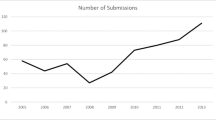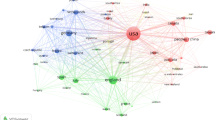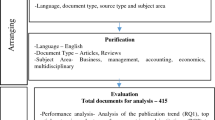Abstract
This study conducts a citation-based comprehensive systematic literature review (SLR) of the syndicated loan market by identifying and recognizing the sources of knowledge-producing leading articles, journals and authors in this area. In total, we present a citation analysis of 374 articles from the Scopus database using a comprehensive list of keyword searches. We find that the importance of research using syndicated loan data has increased after the global financial crisis (GFC). It is perhaps due to the reason that the GFC was mainly a credit crisis that sparked the interest of research in this area. We identify the Journal of Financial Economics as the leading journal in terms of citation and the Journal of Banking and Finance in terms of publication count. Victoria Ivashina comes out as the leading author in terms of the citation count and Anthony Saunders in terms of publication count. We also perform a content analysis of the top 100 most cited papers and identify data characteristics, major themes, estimation techniques and empirical approaches. Our SLR provides a macro picture of research on syndicated loan studies. Finally, we provide an overview of the direction for future research.











Similar content being viewed by others
Notes
Search key in SCOPUS database TITLE-ABS-KEY (( "syndicat* loan*" OR "project finance" OR "corporate loan*") OR (syndicat* AND ( loan* OR bank*)) OR (dealscan OR loanware OR dealogic OR "Thomson One").
Although the first paper on the mathematical theory of banking was published in 1888, the research on banking started picking from the 1970s. Another earlier paper on the theory of banking is by Klein (1971).
We consider all the dependent variables if a paper uses multiple dependent variables.
References
Acharya VV, Eisert T, Eufinger C, Hirsch C (2018) Real effects of the sovereign debt crisis in Europe: evidence from syndicated loans. Rev Financ Stud 31(8):2855–2896
Ahmad N, Bibi A (2023) Responsible management education: mapping the trends, influential sources and research themes. Manage Sustain Arab Rev 2(1):6–24
Ahmad N, Menegaki AN, Al-Muharrami S (2020) Systematic literature review of tourism growth nexus: an overview of the literature and a content analysis of 100 most influential papers. J Econ Surv 34(5):1068–1110
Amiraslani H, Donovan J, Phillips MA, Wittenberg-Moerman R (2023) Contracting in the dark: the rise of public-side lenders in the syndicated loan market. J Account Econ 76(1):101586
Anwar J, Bibi A, Ahmad N (2021) Behavioral strategy: mapping the trends, sources and intellectual evolution. J Strateg Manag 15(1):140–168
Asatullaeva Z, Aghdam RFZ, Ahmad N, Tashpulatova L (2021) The impact of foreign aid on economic development: a systematic literature review and content analysis of the top 50 most influential papers. J Int Dev 33(4):717–751
Bae K, Goyal VK (2009) Creditor rights, enforcement, and bank loans. J Financ 64(2):823–860
Ball R, Bushman RM, Vasvari FP (2008) The debt-contracting value of accounting information and loan syndicate structure. J Account Res 46(2):247–287
Becker B, Ivashina V (2018) Financial repression in the European sovereign debt crisis. Rev Financ 22(1):83–115
Berg T, Saunders A, Steffen S (2016) The total cost of corporate borrowing in the loan market: don’t ignore the fees. J Financ 71(3):1357–1392
Berlin M et al (2020) Concentration of control rights in leveraged loan syndicates. J Financ Econ 137(1):249–271
Bermpei T, Degl’Innocenti, M., Kalyva, A.N., & Zhou, S. (2023) Lender indvidualism and monitoring: evidence from syndicated loans. J Financ Stab 66:101123
Bharath S, Dahiya S, Saunders A, Srinivasan Al (2007) So what do I get? The bank’s view of lending relationships. J Financ Econ 85(2):368–419
Bharath ST, Dahiya S, Saunders A, Srinivasan A (2011) Lending relationships and loan contract terms. Rev Financ Stud 24(4):1141–1203
Botsch M, Vanasco V (2019) Learning by lending. J Financ Int 37(C):1–14
Bradley M, Roberts MR (2015) The structure and pricing of corporate debt covenants. Quart J Financ 5(2):1550001
Calem P, Correa R, Lee SJ (2020) Prudential policies and their impact on credit in the United States. J Financ Intermed 42:100826
Chava S (2014) Environmental externalities and cost of capital. Manage Sci 60(9):2223–2247
Cumming D, Lopez-de-Silanes F, McCahery JA (2020) Tranching in the syndicated loan market around the world. J Int Bus Stud 51:95–120
Dennis SA, Mullineaux DJ (2000) Syndicated loans. J Financ Intermed 9(4):404–426
Dichev ID, Skinner DJ (2002) Large–sample evidence on the debt covenant hypothesis. J Account Res 40(4):1091–1123
Drucker S, Puri M (2005) Banks and capital markets: a survey. In: Eckbo BE (ed) Amsterdam: empirical corporate finance. Elsevier/North-Holland Publishers, Amsterdam
Drucker S, Puri M (2005) On the benefits of concurrent lending and underwriting. J Financ Forthcom 60(6):2763–2799
Edgeworth F (1888) A mathematical theory of banking. J Roy Stat Soc 51(1):113–127
Esty BC, Megginson WL (2003) Creditor rights, enforcement, and debt ownership structure: evidence from the global syndicated loan market. J Financ Quant Anal 38(1):37–59
Fang X, Li Y, Xin B, Zhang W (2016) Financial statement comparability and debt contracting: evidence from the syndicated loan market. Account Horiz 30(2):277–303
Fiaz A, Ahmad N, Al-Abri A, Khurshid N, Menegaki A (2023) Exchange rate misalignment: a systematic literature review based on citation and content analysis. OPEC Energy Rev. https://doi.org/10.1111/opec.12278
Giannetti M, Laeven L (2012) The flight home effect: evidence from the syndicated loan market during financial crises. J Financ Econ 104(1):23–43
Giannetti M, Yafeh Y (2012) Do cultural differences between contracting parties matter? Evidence from syndicated bank loans. Manage Sci 58(2):365–383
Gong D, Xu J, Yan J (2023) National development banks and lona contract terms: evidence from syndicated loans. J Financ Stab 130:102763
Harvey CR, Lins KV, Roper AH (2004) The effect of capital structure when expected agency costs are extreme. J Financ Econ 74(1):3–30
Haselmann R, Wachtel P (2011) Foreign banks in syndicated loan markets. J Bank Finance 35(10):2679–2689
Ho K, Wong A (2023) Effect of cliamte-related risk on the costs of bank loans: evidence from syndicated loan markets in emerging economies. Emerg Mark Rev 55:100977
Hussain SM, Ahmad N, Ahmed S (2023) Applications of high-frequency data in finance: a bibliometric literature review. Int Rev Financ Anal 89:102790
Hussain SM, Ahmad N, Fazal F, Menegaki AN (2023) The impact of female directorship on firm performance: a systematic literature review. Rev Manage Sci. https://doi.org/10.1007/s11846-023-00677-2
Ivashina V (2009) Asymmetric information effects on loan spreads. J Financ Econ 92(2):300–319
Ivashina V, Scharfstein D (2010) Bank lending during the financial crisis of 2008. J Financ Econ 97(3):319–338
Jiang W, Li K, Shao P (2010) When shareholders are creditors: effects of the simultaneous holding of equity and debt by non-commercial banking institutions. Rev Financ Stud 23(10):3595–3637
Kitchenham B, Brereton OP, Budgen D, Turner M, Bailey J, Linkman S (2009) Systematic literature reviews in software engineering–A systematic literature review. Inf Softw Technol 51:7–15
Li SX, Rowley TJ (2002) Inertia and evaluation mechanisms in interorganizational partner selection: syndicate formation among U.S. investment banks. Acad Manage J 45(6):1104–1119
Li C, Luo Y, Vita GD (2023) Civil conflicta and cross-border lending; a sectoral, micro lender-level analysis of syndicated loans. Defense Peace Econ. https://doi.org/10.1080/10242694.2023.2205311
Liu C, Xu L, Yang H, Zhang W (2023) Prosocial CEOs and the cost of debt: evidence from syndicated loan contracts. J Corp Finan 78:102316
Maskara PK (2010) Economic value in tranching of syndicated loans. J Bank Financ 34(5):946–955
Massoud N, Nandy D, Saunders A, Song K (2011) Do hedge funds trade on private information? Evidence from syndicated lending and short-selling. J Financ Econ 99(3):477–499
Menegaki AN, Ahmad N, Aghdam RF, Naz A (2021) The convergence in various dimensions of energy-economy-environment linkages: a comprehensive citation-based systematic literature review. Energy Econ 104:105653
Qian J, Strahan PE (2007) How laws and institutions shape financial contracts: the case of bank loans. J Financ 62(6):2803–2834
Santos JAC (2011) Bank corporate loan pricing following the subprime crisis. Rev Financ Stud 24(6):1916–1943
Schenone C (2010) Lending relationships and information rents: do banks exploit their information advantages? Rev Financ Stud 23(3):1149–1199
Shen Y-P, Wu C-Y, Lu C (2023) U.S. REIT banking relationships and syndicated loan pricing. Rev Quant Financ Acc 61:447–479
Siegel JI, Licht AN, Schwartz SH (2011) Egalitarianism and international investment. J Financ Econ 102(3):621–642
Smajić H, Palalić R, Ahmad N (2022) Future perspective of socioemotional wealth (SEW) in family businesses. J Family Bus Manage 13(4):923–954
Sufi A (2007) Information asymmetry and financing arrangements: evidence from syndicated loans. J Financ 62(2):629–668
Sufi A (2009) The real effects of debt certification: evidence from the introduction of bank loan ratings. Rev Financ Stud 22(4):1659–1691
Wakefield A (2014) Searching and critiquing the research literature. Nurs Stand 28(39):49–57
Weidner D (2000) Syndicated lending closes out ’90s on a tear. Am Bank 165(6):1
Wittenberg-Moerman R (2008) The role of information asymmetry and financial reporting quality in debt trading: evidence from the secondary loan market. J Account Econ 46(2–3):240–260
Zhang D, Zhang Y, Zhao Y (2023) Lending relationships and the pricing of syndicated loans. Manage Sci. https://doi.org/10.1287/mnsc.2023.4730
Author information
Authors and Affiliations
Corresponding author
Additional information
Publisher's Note
Springer Nature remains neutral with regard to jurisdictional claims in published maps and institutional affiliations.
Rights and permissions
Springer Nature or its licensor (e.g. a society or other partner) holds exclusive rights to this article under a publishing agreement with the author(s) or other rightsholder(s); author self-archiving of the accepted manuscript version of this article is solely governed by the terms of such publishing agreement and applicable law.
About this article
Cite this article
Saharti, M., Chaudhry, S.M., Ahmad, N. et al. Syndicated loans: mapping the trends, sources and intellectual evolution. Rev Quant Finan Acc 62, 1569–1592 (2024). https://doi.org/10.1007/s11156-024-01243-x
Accepted:
Published:
Issue Date:
DOI: https://doi.org/10.1007/s11156-024-01243-x




